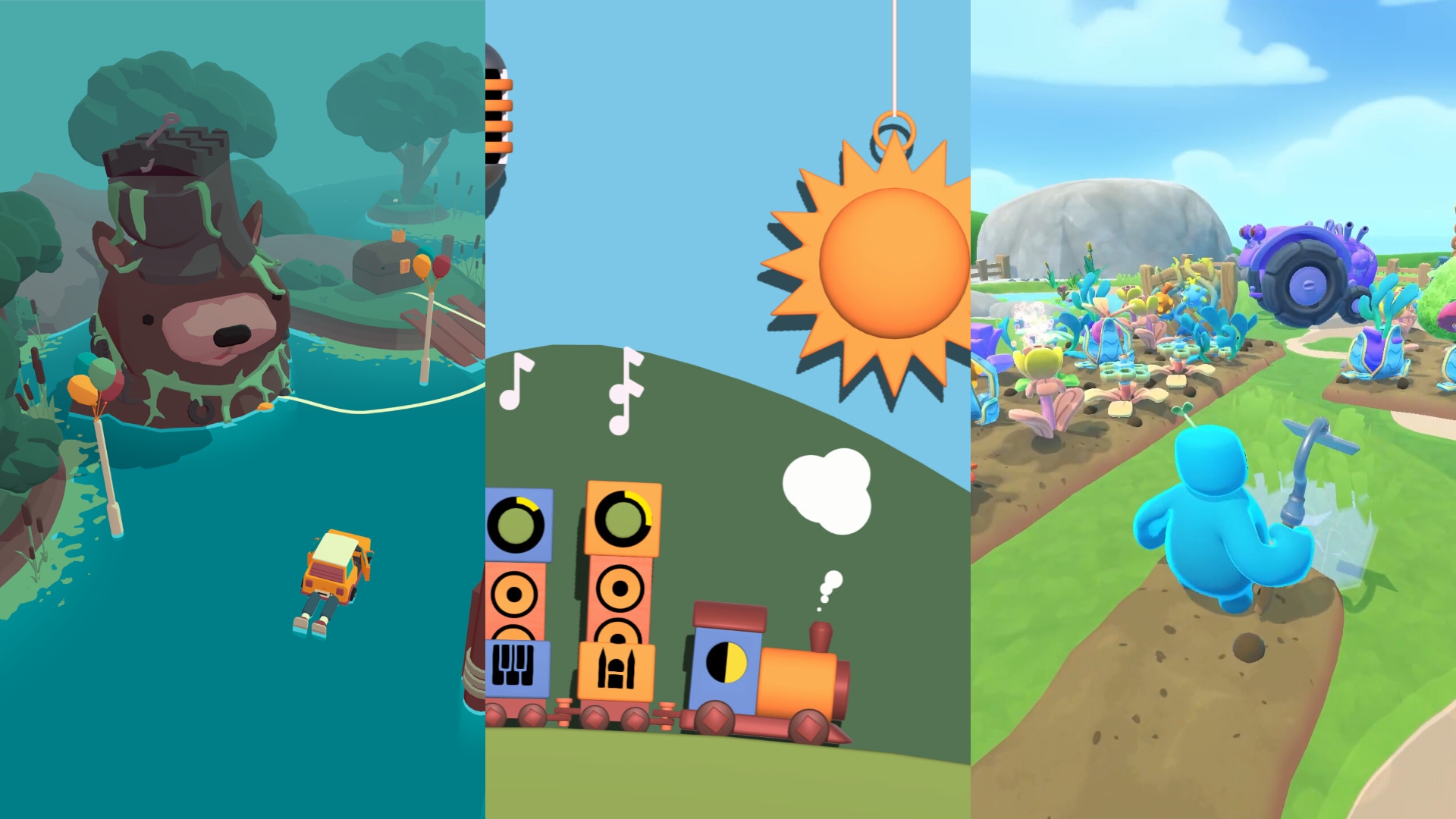This week I’ve played a couple of expanded demos and betas for titles I’ve played previously. I also explored a new whimsical and musical demo I’ve been looking forward to. Short and sweet this week, on to the games!
What the Car? – Expanded Steam Demo

A few months ago, I played the first demo of Triband’s game, What the Car? Now, I’ve been lucky enough to play an extended game demo. If you haven’t played the previous demo or just haven’t heard of What the Car? it is a physics and nonsense-based “racing” game. I say “racing” because while you are frequently a sort of car and there are different tracks to navigate, there’s no competition or logic to what is happening.
Each level begins with a new type of vehicle. Will it be a car with a jetpack? Will it be a car riding a bike? Maybe it will be the Cronenberg-esque horror of Car with Legs/Many Legs/ Too Many Legs. Each iteration of transportation has different abilities that operate with the Space Bar. Some will jump, some will fire rockets for a speed boost, and some will simply tumble around the map with their multiple legs flying in the face of all spectators.
This new demo features a substantial number of levels, including some secrets hidden around the place. For example, there is a hidden water level somewhere on the map, and elsewhere, there is a hidden QR code that will send you a nice little treat. Many more areas are available in this version of the demo. There are water levels, swamp levels, levels based on city streets, and several of the mega hard levels thrown in. How can you tell if you have found one of the mega hard levels? Well, Triband has marked them very subtly with loads of skulls, and to reach any of them, you have to enter the mouth of a massive skull and follow the bony path of its spine to reach the level. Subtle, minimalist, doom-inducing.
The mega-hard levels are, and this may be a surprise to you, mega-hard. I managed to complete one of the ones included in this demo. I found them all, but completing them is another story entirely, especially when you are but a pawn of physics and mutant cars. Otherwise, I did complete every other level and found the hidden polaroid frame in each. You don’t need to find the hidden frame to finish, but it does make you feel like the world’s greatest driver.
It’s incredibly silly and hugely entertaining. While the mega-hard levels do occasionally stray into frustration territory, they are doable with enough practice. It matches Triband’s previous title What the Golf? for madness and sneakiness in terms of hidden things. Some community-made levels are included in the demo because it has been available on Apple Arcade for some time.
Since the first demo, I haven’t stopped entering the room and singing “Car with BIG LEGS!” and now I shall also be adding “Ice Ice Leggy” to my repertoire of vocal stims. Apologies to anyone who has ever spoken to me in person.
What the Car? is available now on Apple Arcade and will be released on Steam on September 9.
Oddada

Oddada is an upcoming music crafting game from developers Sven Ahlgrimm and Mathilde Hoffmann. There’s no objective other than to create music. Designed as a series of different scenes, there are landscapes and gadgets that you can manipulate to create your music tracks. A small toy train leads you from scene to scene and records each track you create.
When you enter a new scene, you will see some kind of interactable board or toy. There will also be objects you can place on the board that will change how notes are played. For example, one of the boards in the demo is a landscape that rises and falls in waves when started. Then, to create your track, you place tiny houses and blocks on the landscape. When the houses rise on the wave, it will make a sound. You can also alter the not by placing the houses on top of filler blocks to make them higher.
The little train that leads you through the demo also has some fun buttons you can play with. Three buttons will change the color palette and tone of the music. Night mode will darken the scene but also alter the sound. The snow button will make everything pastel with a sonorous resonance added to the sounds. The Sun button will make everything boldly colored and create a clear sound. The train will also record your pieces when you are done with them, and at the end, you can layer them all to create a complete musical piece. Then, it’s time to commit the result to a cassette tape, customize it, and start all over again if you want.
As someone who loves putting together music but cannot read music or play any instrument, games like Oddada and other electronic programs allow me to create. Oddada is a beautiful example of nostalgic visuals combined with modern music-making that makes creativity fun and stress-free.
Oddada has a free demo available on Steam now with a release date TBA.
Southfield – Closed Beta

I played an early demo for this physics-based farming sim from Radical Forge a while back. Now, I’ve been taking part in the most recent beta, where there is a whole lot more content and physics fun going on. You play as a wibbly wobbly plant person, (Bud) who sprouts from the ground ready and raring to farm. You are also gifted with the majestic ability to ragdoll and become a ball, allowing you to roll around at the speed of sound.
The layout of the world has changed and expanded, and a greatly expanded roster of crops has been added. There is also a lot more that you can craft and decorate with this new beta, which feels dangerously close to the upcoming early access release. Some areas are blocked off, but there is still a large world to explore. There are also some different characters to meet: A very grumpy living furnace man who will help you level up your tools, roaming sellers who will have seeds and other goodies, and the son of a grumpy forge man who is considerably less grumpy than his dad.
There are a few short tutorial challenges to teach you the basics of farming, crafting, and building before you are left to your own devices. It’s relatively standard farming sim stuff but with some fun twists. Yes, you can harvest in the usual way with a scythe. You can also grab crops and pull them out of the ground using the power of physics! Grab the plant and run with it until it pops out of the ground. You can then eat crops for energy, put them in your inventory to sell later, or make more seeds in the seed maker you can craft.
Another aspect of the crops you can grow or find in the world is that many of them will have different effects when you eat them. Some will display this effect when you harvest them. Others give it away in the name. For example, a Gloop Glop will cover you in gross green goo, and a Cinderflume will set you on fire. These effects may be useful in the world. Look out for chests in the wild that are locked by elemental effects. Maybe there’s a fruit for that.
There are also some nighttime specters to deal with in the shape of Ruffians. Ruffians are ghostly gloop glops that float around and can attack you. They can also leave behind ooze, which is useful for crafting. Speaking of crafting, you can also create automation for your farm so you can just wander around the weird world.
All these positives also highlight the major negative still in the game: the movement. Yes, it’s physics-based, but it is also still extremely glitchy and buggy. Jumping will often see you get stuck up to your waist in the ground roughly 80% of the time. You will just randomly ragdoll for no reason. Sometimes you will grab things, sometimes you won’t. It’s all still very imprecise and can get frustrating when exploring for any length of time. Overall, once these issues are resolved, I think Southfield will be a stellar and silly farm sim that you can spend hours with.
Southfield is coming soon to early access on Steam.
For more indie coverage, check out our weekly round-up of the latest indie releases.


